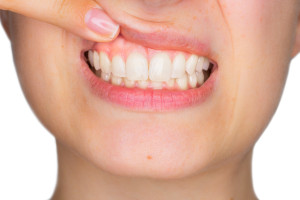 How do you know if you have healthy gums? The only way to know for sure is to see your dentist regularly for cleanings and exams. In between those appointments there are a number of things to look for. Let’s start with color.
How do you know if you have healthy gums? The only way to know for sure is to see your dentist regularly for cleanings and exams. In between those appointments there are a number of things to look for. Let’s start with color.
Pink
It’s likely no surprise that pink gums indicate optimal gum health. But also look for firmness. Firm, pink gums are signs that you’re doing things right—brushing and flossing regularly.
Pink: Firm, pink gums are a great sign of healthy, maintained gums.
Brown
Folks with darker skin, don’t fret if your gums are a brownish color. That’s likely your natural color, so check for firmness to determine health. Lighter skinned folks, take note if you have brownish gums. It could be a reaction to being in the sun a lot since sun exposure can cause the melanin in your gums to darken.
Just like pink gums, brown gums should be firm. In addition, keep an eye out for color changes to the edges around your teeth, which could indicate the impacts of:
- Dark-coloured foods and drinks especially those with artificial colors
- Nicotine and tobacco
- Tartar build up
- Tooth decay
- Age-related enamel wear
Purple
Purple colored gums do not necessarily indicate a problem. Variations in red-based colors like pink and purple are normal. What you should be considering more than color in this case are signs of infection, such as:
- Sensitivity
- Pain
- Swelling
Red
When gums inflame, they are likely infected. If they are sensitive or if they bleed during brushing and flossing, you should contact your dental provider right away.
Yellow
Yellow is the color of fear for pretty good reason when it comes to your gums. That’s because a slight yellow tint or film on your gums is an indicator of gingivitis. And if your yellowish gums are swollen, then it’s almost certainly a case of gingivitis. The good news is that the condition is remedied with a visit to the dentist and improved oral care.
It’s important to note that gums with yellow sores are probably something else, such as an ulcer or viral infection.
Black
If your gums are black and you haven’t been eating gobs of licorice, then you probably are seeing the effects of tobacco and/or certain medications. Both doctors and dentists can advise you in situations like this. If it’s medication related, you may want to start with your doctor.
White
When the filmy substance over your gums is white, there’s typically a fungal infection going on. Gums infected with a fungus will be sore and sensitive and just plain uncomfortable. Don’t let this develop. See your doctor any time you see something like this developing.
Grey
Film over your gums can also become grey, and it’s almost never a good sign. It can be a sign of stress, a reaction to smoking, a bacterial infection, or a weakened immune system. Since some of those things can be serious, grey gums means you should be going to the doctor and getting medical attention.
Symptoms
Color change is just one thing to look for when it comes to evaluating gum health. There are other symptoms to note, too.
Bleeding Gums
Brushing and flossing regularly is a good thing. Bleeding after brushing or flossing is not a good thing. Typically, the bleeding is due to the build-up of plaque at the base of the tooth. This causes your gums to become red or swollen, which leads to bleeding.
Sometimes after a consistent routine of brushing and flossing is established the bleeding stops. When it doesn’t, it’s time to contact your dentist.
Metal Taste
In many cases, the metal taste in your mouth is from residual blood that did not get rinsed out after brushing and flossing.
Halitosis
Halitosis means bad breath but not all bad breath is equal. Some bad breath comes from the stomach and esophagus, and it often smells like a really bad version of the food you recently ate. Sometimes, you may even experience an aftertaste as the food “repeats on you.”
But your gums can also contribute to halitosis as bacteria can fester inside them. This foul-smelling, non-foodlike odor is harder to notice on yourself than it is on others. These toxins can be mitigated with brushing, flossing and even using mouthwash after brushing and flossing.
Excess Saliva
Saliva is a miracle liquid, it helps fight bacteria in your mouth and makes it far easier to swallow food than if there were no such thing. But like all good things, too much saliva could be a sign of too much bacteria, which causes gum disease.







Leave a Reply